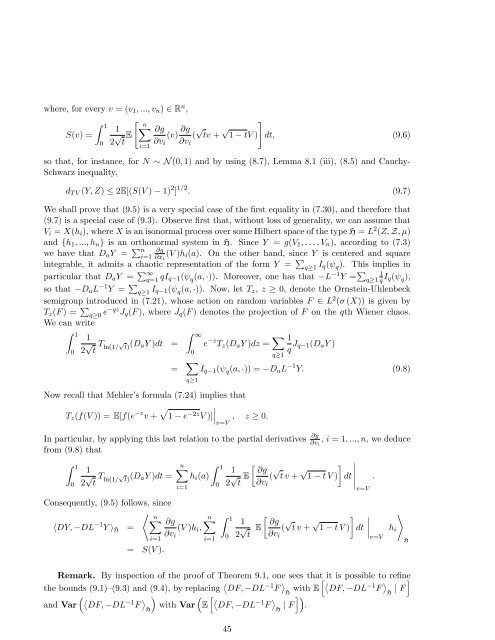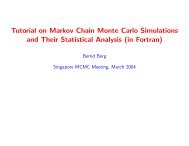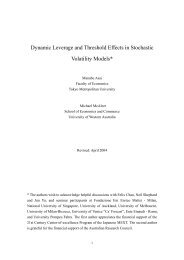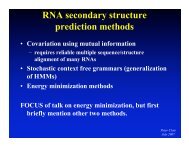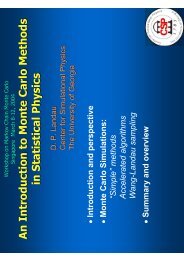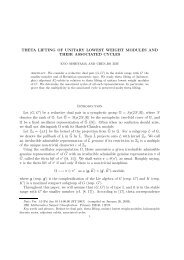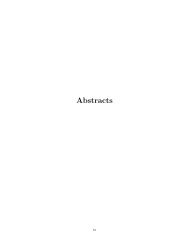Stein's method, Malliavin calculus and infinite-dimensional Gaussian
Stein's method, Malliavin calculus and infinite-dimensional Gaussian
Stein's method, Malliavin calculus and infinite-dimensional Gaussian
You also want an ePaper? Increase the reach of your titles
YUMPU automatically turns print PDFs into web optimized ePapers that Google loves.
where, for every v = (v 1 ; :::; v n ) 2 R n ,<br />
Z "<br />
1<br />
nX<br />
1<br />
S(v) =<br />
0 2 p t E @g<br />
(v) @g ( p tv + p #<br />
1 tV ) dt; (9.6)<br />
@v<br />
i=1 i @v i<br />
so that, for instance, for N N (0; 1) <strong>and</strong> by using (8.7), Lemma 8.1 (iii), (8.5) <strong>and</strong> Cauchy-<br />
Schwarz inequality,<br />
d T V (Y; Z) 2E[(S(V ) 1) 2 ] 1=2 : (9.7)<br />
We shall prove that (9.5) is a very special case of the …rst equality in (7.30), <strong>and</strong> therefore that<br />
(9.7) is a special case of (9.3). Observe …rst that, without loss of generality, we can assume that<br />
V i = X(h i ), where X is an isonormal process over some Hilbert space of the type H = L 2 (Z; Z; )<br />
<strong>and</strong> fh 1 ; :::; h n g is an orthonormal system in H. Since Y = g(V 1 ; : : : ; V n ), according to (7.3)<br />
we have that D a Y = P n @g<br />
i=1 @x i<br />
(V )h i (a). On the other h<strong>and</strong>, since Y is centered <strong>and</strong> square<br />
integrable, it admits a chaotic representation of the form Y = P q1 I q( q ). This implies in<br />
particular that D a Y = P 1<br />
q=1 qI q 1( q (a; )). Moreover, one has that L 1 Y = P q1 1 q I q( q ),<br />
so that D a L 1 Y = P q1 I q 1( q (a; )). Now, let T z , z 0, denote the Ornstein-Uhlenbeck<br />
semigroup introduced in (7.21), whose action on r<strong>and</strong>om variables F 2 L 2 ( (X)) is given by<br />
T z (F ) = P q0 e qz J q (F ), where J q (F ) denotes the projection of F on the qth Wiener chaos.<br />
We can write<br />
Z 1<br />
0<br />
1<br />
2 p t T ln(1= p t) (D aY )dt =<br />
Z 1<br />
0<br />
e z T z (D a Y )dz = X q1<br />
1<br />
q J q 1(D a Y )<br />
= X q1<br />
I q 1 ( q (a; )) = D a L 1 Y: (9.8)<br />
Now recall that Mehler’s formula (7.24) implies that<br />
T z (f(V )) = E[f(e z v + p 1 e 2z V )] ; z 0:<br />
v=V<br />
In particular, by applying this last relation to the partial derivatives @g<br />
@v i<br />
, i = 1; :::; n, we deduce<br />
from (9.8) that<br />
Z 1<br />
0<br />
1<br />
2 p t T ln(1= p t) (D aY )dt =<br />
nX<br />
i=1<br />
Z 1<br />
<br />
1 @g<br />
h i (a)<br />
0 2 p t E ( p t v + p <br />
1 t V ) dt<br />
@v i<br />
:<br />
<br />
v=V<br />
Consequently, (9.5) follows, since<br />
* nX<br />
hDY; DL 1 @g<br />
nX<br />
Y i H = (V )h i ;<br />
@v<br />
i=1 i<br />
= S(V ):<br />
i=1<br />
Z 1<br />
0<br />
<br />
1 @g<br />
2 p t E ( p t v + p <br />
1 t V ) dt<br />
@v i<br />
+<br />
h i<br />
v=V<br />
H<br />
Remark. By inspection of the proof of Theorem 9.1, one sees that it is possible to re…ne<br />
the bounds (9.1)–(9.3) <strong>and</strong> (9.4), by replacing DF; DL 1 F h DF;<br />
H with E DL 1 F i<br />
H<br />
j F DF;<br />
<strong>and</strong> Var DL 1 F h DF;<br />
with Var E<br />
H<br />
DL 1 F i<br />
H j F .<br />
45


